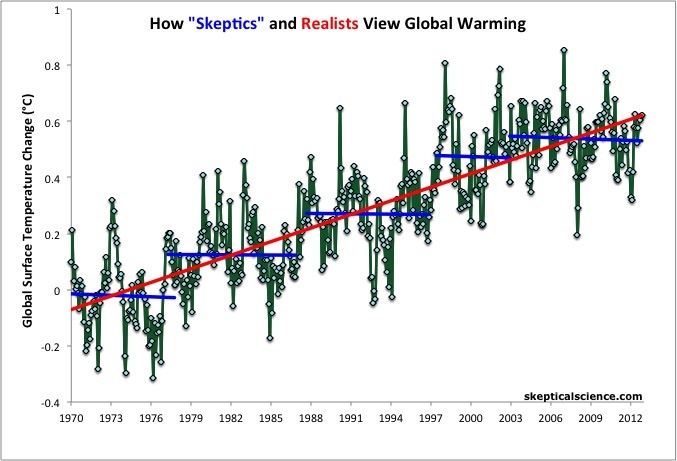Another scientific dagger to the deniers
Global warming has stopped for the past 15 years, and there has been cooling since 1998, while CO2 levels have continued to rise – ipso facto, global warming is a leftist fraud.
I’m sure you’ve heard this argument many times. Like any successfully spread falsehood it has a grain of easy to understand truth – the rate at which the surface temperatures have been rising has slowed over the last few years and they are at the low end projected by climate models. But it conveniently leaves out a range of other information that would lead most people to realise that global warming is still a concern.
Firstly, it’s important to recognise that according to the World Meteorological Organisation, 13 of the 14 hottest years since the instrumental record began have occurred this century – including 2010 and 2005, the two warmest. Also, the extraordinary heat of 1998 was boosted by an especially intense El Nino event while the heat of 2010 wasn’t. Also, 2013 was the hottest ever for Australia, according to our Bureau of Meteorology.
So it’s not as if suddenly global warming has dramatically reversed into global cooling.
In addition, a new study published today in the scientific journal Nature Climate Change helps to explain how the warming effect of carbon emissions is still building up, but hasn’t fully flowed through to the temperatures measured at the planet’s surface. Led by Professor Matthew England of the University of NSW, the study finds that unusually high trade winds in the Pacific Ocean (pushing from east to west) have acted to invigorate the circulation of the Pacific Ocean, causing more heat to be taken out of the atmosphere and transferred into the subsurface ocean around the western Pacific while bringing cooler waters to the surface around the eastern Pacific.
These cooler waters in the eastern Pacific have then acted to moderate surface temperatures around a significant proportion of the globe. Essentially, carbon emissions are causing the earth to warm, it’s just a greater proportion of this heat is being transferred to the ocean rather than residing in the air. This study is explained further in another piece we’ve published today.
Ultimately the end conclusion is rather sobering.
Professor England notes that, “this pumping of heat into the ocean is not very deep, however, and once the winds abate, heat is returned rapidly to the atmosphere”.
According to England, this enhanced uptake of heat by the ocean is by no means permanent, stating:
“When the trade wind strength returns to normal – as it inevitably will – our research suggests heat will quickly accumulate in the atmosphere. So global temperatures look set to rise rapidly out of the hiatus, returning to the levels projected within as little as a decade."
One of the key tricks of the pro-fossil fuel, anti-science lobby has been to suggest that the climate scientists ignore natural factors that influence global climate and so unduly place blame on greenhouse gas emissions associated with human activity. The argument goes, ‘the globe’s climate has always changed over the eons, this is all just natural’. In trying to explain away the warming trend we’ve seen since the beginning of the industrial revolution they’ll claim changes in the planet’s orbit or point to variation in the sun’s output, or aerosols, or changes in the ozone layer or El Nino events or volcanoes. Anything other than carbon dioxide, methane or N2O associated with human activity is at work, they say.
These all provide highly useful red herrings because it is true that our climate is heavily influenced by natural factors, and even human factors other than greenhouse gas emissions (for example, the human product of smog has acted to filter out sun and cool sections of the planet – while simultaneously making many people sick).
Yet in the end all of these factors are analysed by professional climate scientists in trying to isolate the warming effect of GHGs. Sometimes these non-GHG drivers of climate act to accentuate warming and sometimes they act to moderate it. That’s why the warming of the planet’s surface is not some simple straightforward function of the level of carbon emissions in the atmosphere. Instead, warming has proceeded in fits and starts with lots of up and downs between individual years. But these natural features are expected to be overwhelmed with time by the longer term, sustained effect of rising concentrations of greenhouse gases.
The chart below from the team at Sceptical Science helps to illustrate that if you cherry-pick your data cleverly you can isolate decadal sections of time where temperature appears to stablise or slightly decline (the blue lines). But steadily over time the warming effect of carbon emissions wins out (the red line).

Source: http://www.skepticalscience.com/graphics.php?g=47
This new research from Prof England and colleagues illustrates that natural factors will periodically act to disguise the warming influence of rising greenhouse gases. But their effect tends to be transient. Meanwhile, greenhouse gases will have impacts that will last many decades to centuries.















